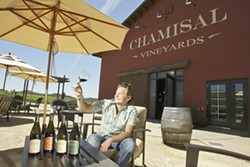
- PHOTO BY STEVE E. MILLER
- INSPIRED : Fintan du Fresne has produced a remarkable Pinot Noir in addition to stellar Pinot Gris and Chardonnays at the gorgeous Chamisal Vineyard in Edna Valley.
“Pinot Gris can be hit or miss in Edna Valley, unlike Oregon’s Willamette Valley or France’s Alsace appellation, which produce consistently good ones each vintage,” Fin said candidly, while pouring the new 2009 estate Pinot Gris. It was stainless steel fermented to retain the natural spiciness and fruit flavors, racked to neutral oak barrels, bottled, and it’s always released earlier. “Edna Valley can produce an exceptional Pinot Gris. It’s a wine you can have fun with and change each year. Some years, if it needs it, we ferment it in neutral oak barrels. We’ve found new oak tends to overwhelm it.”
For his new label, Encantado (which replaced the DA White and DA Red labels), Fin made a 2008 Chardonnay/Pinot Gris blend (60/40 percent, respectively). This tasty, food-friendly white is commonly referred to as a “porch pounder” by the wine industry: It’s easy to drink and has a low alcohol content. “It expresses the nuttiness of aged Pinot Gris yet remains graceful and fruit-driven,” Fin pointed out. As usual, I liked his Stainless Steel Chardonnay 2009. “It’s all about good fruit, purity and freshness. We make it in the style of Marlborough, New Zealand (NZ), Sauvignon Blanc with the same yeast,” he explained. “The money we save on buying new barrels is used to buy better [quality] grapes.”
His 2008 Chardonnays were just as he described, friendly and drinkable now, yet still age-worthy. The estate Chardonnay, 100-percent barrel fermented and malolactic fermentation, offered ripe fruit flavors, good concentration, and the tropical fruit notes he prefers. He had recently bottled some of the wines we tasted and wryly explained: “I love bottling. Once you get it in the bottle there’s nothing more you can do to the wine. But it’s also a stressful time because once you’ve bottled the wine, there’s nothing more you can do with it.” However, he said the 2008 vintage wines were easy to make. “A good vintage makes itself, blends itself. When it’s a tough vintage you have to work at it throughout the process, from harvest to blending.”
The 2008 Chardonnay Califa, their reserve designation, which is a Chumash Indian term meaning “most beautiful one,” is a blend of the three finest clonal selections from individually picked barrels. Even with 60 percent new oak, the wine was balanced and retained elegance. Only the best wine lots, in both the Chardonnay and the Pinot Noir, make the final cut to be designated Califa. Because the 2007 Califa sold out quickly, the 2008 will be available earlier this year.
- FIND IT HERE: Chamisal Vineyard,7525 Orcutt Road, SLO
541-9463, Open daily, 10 a.m. – 5 p.m.
The 2008 reds were equally delicious. We started with the estate Pinot Noir, which he described as showing typical Edna Valley characteristics. Loaded with bright cherry, black berries, spice, and cola aromas and flavors, Fin pointed out its riper blackberry notes. I vividly remember tasting these clones in their first years of production, particularly clone 667, which expressed bright raspberry flavors. He explained that as the vines matured the red fruit flavors changed to darker, denser, black-fruit aromas and flavors.
Like the estate, the ’08 Pinot Noir Califa is rich, ripe, and flavorful yet quite balanced and elegant. A blend of what the stat sheet described as their best clones, 2A, 667 and 777, it’s a blend of strawberry and blackberry aromas and flavors, layered with notes of spicy oak and bright citrus, and a long delicious finish. It will be drinkable early but you’ll want to cellar a few bottles to taste as it evolves over the next five years. We finished by tasting the 2007 Encantado Central Coast, a red blend with Grenache, Syrah, and Cabernet Sauvignon. Not an estate wine, some of the grapes were from Paso Robles. It’s a tasty wine, very Rhone-like, but I preferred his 2009 Rose, which I tasted later at home. Mostly Pinot Noir, it’s a pretty quaffer that’s easy to drink and definitely fits the category of porch pounder.
Beyond their organically farmed vineyard, their new organic vegetable garden grows heirloom tomatoes, lettuce, and other other treats for an upcoming hamburger night featuring chef Maegen Loring of SLO (who owned the popular Park restaurant; you can learn all about her new restaurant at TheNeonCarrot.com). According to the Chamisal tasting-room manager, Andrea Chan, “farm burger” night will be a family-oriented event on July 10 open to the public, with discounts offered to their club members. The aforementioned 2008s were just released to the wine club and will soon be available to everyone in the tasting room. Tasting fees are $9 for estate wines, $15 for Califa and other reserves, which are refunded with a purchase of two or more bottles. Pick up their calendar for news of events like the annual September “lobsterfest.” The new patio out front provides guests the perfect picnic site. It’s a great spot for enjoying Fin’s excellent wines and taking in the panoramic views of beautiful Edna Valley wine country.
You can reach New Times’ Cuisine columnist at [email protected].
Comments